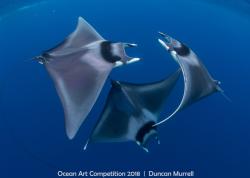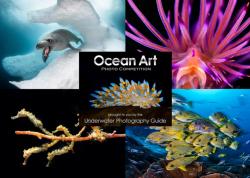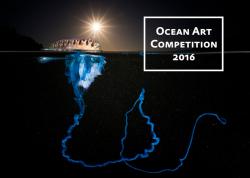Ocean Art Photo Competition 2015 Judges Comments
The Ocean Art Underwater Photo Competition is one of the most prestigious u/w photo contests in the world, attracting a high caliber of entries from photographers around the world. 15 different categories ensure fun competition for all camera classes and disciplines of underwater photography.
If you haven't yet, be sure to check out the 2015 Ocean Art Contest Winners.
Ocean Art would not be possible without our esteemed judging panel, who have decades of experience and have earned some of the most prestigious awards in diving, photo and video industries.
Here is what our judges had to say about this year's competition.
Marty Snyderman
The author of Dive Training magazine's Behind the Lens column, Marty Snyderman has made his living as an underwater photographer, photography instructor, author and speaker for close to 40 years.
First of all, I would like to say congratulations to all of the photographers that won any category, and to those that images recognized in any way! Every category had strong images, and you have every right to feel proud. And now that you have had a moment to pat yourself on the back along with all of us doing the same, gear up. Next year's competition is certain to be even stronger!
The fact is, the images are better and better every year. That is one of the reasons I so thoroughly enjoy participating as a judge. I also continue to learn from Scott, Martin and Tony. We all see the world and photography through different eyes, and I truly enjoy and appreciate their photographic insights. While we agree and disagree about various images, it is very clear that everyone takes their responsibility seriously.
With regard to any advice I have for contestants: Read the rules and guidelines carefully so that you are in compliance and so you enter your images in the appropriate category. Be very careful about "over-processing" images. Images that look great on Facebook or other social media often show processing flaws when enlarged.
As always, enjoy the process of creating and sharing images, not just the processed images and judging results!
I wish everyone a great 2016, and look forward to seeing your images in next year's contest!
- Marty Snyderman
Martin Edge
Author of "The Underwater Photographer," a best selling book on learning underwater photography.
www.edgeunderwaterphotography.com
For those of you who are new to underwater photography competitions or are perhaps a little frustrated with your progression through the process then I may have a few words for you.
The standard of this year's "Ocean Art Competition" was very strong indeed but during the first round some of the participants made it a little easier for our judging panel of Tony Wu, Marty Snyderman and myself. From my own point of view the strength of composition was a factor as to who made the second cut. So here are a few tips for next time!
We don't purposely go looking for compositional flaws. They stick out like a sore thumb. Distractions close to the edge of the image attract the viewer and so often lead the eye out of the frame. We move on to another image and seldom look back.
There were too many cluttered backgrounds in the 1st round. You have to pay attention to what is behind your main subject and in particular, try to avoid elements which merge into each other.
Aspect ratio! You are allowed to crop your image before you enter the competition, but I felt that too many of you from the 1st round were leaving too much empty space around your subject. It was as though you had to keep to your camera sensor dimensions for some reason. Other successful images were cropped into a variety of shapes which accentuated the strength of the composition. In the final round we had a number of square crops, which also added to the strength of the composition. Whilst I'm on the subject please allow me to continue. Aspect ratio of all Fx and Dx SLR's regardless of sensor size or megapixels use the 3.2 aspect. Micro 4:3rds and many compacts use a 4:3 aspect ratio. Some of you will remember the traditional square 1:1 format such as Hasselblads and Rolleiflexes. Remember, it's all about the image so my advice is to use the best crop for your best composition .
Eyes have to be in focus! If one eye is visible, it has to be in focus. Two eyes visible - both have to be in focus. If you have the best image ever but in your heart you know that one eye is soft then leave it to one side.
And finally. The nature of underwater photography allows us to capture moments in time which would appear upside down to the eye of the viewer. It doesn't mean you have to submit your competition entry in the particular orientation it was taken! If you need to rotate it upside down, back to front, counter clock wise in order to make sense then do so by all means. It's alien for us to do this on land but underwater there are no rules. Images of jelly fish in Snells Window spring to mind but before you decide on format, try viewing them on your screen at home in all ways possible.
- Martin Edge
Tony Wu
Author of a coffee table book entitled Silent Symphony, which received the grand prize for best book of the year at Antibes in 2001. He also won the prestigious Veolia environment wildife photographer of the year award.
I have now had the opportunity to converse with Marty, Martin and Scott for several years in the context of judging the Ocean Art contest. Though we’ve always had a pleasant dialogue with mutual respect, this year, I noticed that our discussion was quite fluid (pun intended), almost as if we could anticipate what everyone else’s views were likely to be.
I suppose this should not come as a surprise, but it still amazed me, given that we don't really communicate extensively throughout the rest of the year!
Anyway, this ease and comfort of discussion facilitated the ability to “get straight to the point” so to speak, focusing in (pun intended again) on critical issues.
The themes that appeared were, no surprise, the same as in years past, and perhaps the same as in most photo contests. I would encourage you to read the comments from last year, as there will most likely be substantial overlap with those provided by the judges this year. (Brent - link to last year’s comment page?)
I’m going to pick three major points to hammer home.
1. Do No Manhandle Marine Life! Yes, it’s obvious when you do. And yes, your photo obviously gets thrown out immediately when I see the obvious manhandling. Cards to prop up nudibranchs? Obvious. Animals that are on backdrops that they would never be caught dead on naturally? Obvious. You and your dive guide may think that you’re being clever, but it’s quite the opposite. Don’t be an obvious dolt.
2. Please enter your image in the correct category. There were, once again, a few images that could have done well, but were entered into the wrong categories. Submitting a behavior shot into the open macro category could work out for you, but it could also, and did in every instance, work against you. It’s sad when I want give an image recognition, but can’t.
3. There is a difference between an impressive subject and an impressive image. Just because you happen to jump in the water with big animals like sharks or whales and snap a photo doesn’t make it a prize-winning image. When you enter an image into a photo contest, photography skills, originality and creativity are important. Take whales for example. I spend a lot of time with them. I can easily see when an image is just “jump in, snap away” vs. “jump in, think, position, capture a beautiful, meaningful moment with solid photo technique.” Ditto with sharks, mantas, etc.
Let me conclude on a positive note, and say that there were a number of “crackers” as Martin would say with his wonderful British accent. You’ll see them among the winners. Congratulations!
There were also some images that required time to settle-in. What I mean is that some images pop as soon as you look at them, but others require a second or third view before you understand them. In other words, they are subtle.
I am particularly fond of subtle. There were a couple of images that I picked and thought: “No one else will like these.” because I tend to be the outlier with every group of judges in every contest. But this time, my fellow judges agreed that the subtlety worked.
In viewing the awarded images, you’ll hopefully see the ones that are obvious vs the ones that are subtle. Both approaches work, and both require skill. Perhaps something to consider for future contests.
Happy, and safe, adventures in 2016.
- Tony Wu
Scott Gietler
Owner of the Underwater Photography Guide, Bluewater Photo, Bluewater Travel, and founder of the Ocean Art photo competition - Scott has been teaching underwater photography workshops around the world for several years.
I want to give a huge congratulations to all of the photographers. This year was our best set of photos yet, and many outstanding images were not even able to make honorable mention. In recognition of this, we added a couple of 5th and 6th places to some of the most competitive categories.
The first place winners, in particular, were very unique and creative photos that will continue to raise the bar for underwater photographers.
A variety of equipment was used to take the photos, but several compact cameras continue to take amazing photos, showing that is it not just the gear, but also the skill of the photographers. This was the first year we had 3 categories dedicated to mirrorless cameras, and the quality of those photos show that mirrorless cameras are here to stay, and will continue to draw sales from the high-end compacts and from dSLRs, especially as more housing manufacturers are starting to support mirrorless.
Myself and the other judges had a strong preference this year for colorful, natural looking photos, that were not too over-processed. Photos taken in the subjects' natural environment did well, where photos of subjects that were artificially moved did not fare as well.
This year had some particularly mind-blowing photos in the Open Behavior category, with many photos that could have won in previous years not even placing in that category. The spawning frogfish photo in particular was such a rare sign to capture, and the photographer did a great job.
Ever year there are trends, and this year was no exception. Last year we saw a lot of turtles & sperm whales, this year we saw a lot of humpback whales, mandarin fish, skeleton shrimp, and jawfish with eggs - along with quite a few photos of the famous Chinchorro crocodile.
If you didn't win this year, I highly encourage you to try again next year, as you never know when your photograph will catch a judge's eye, and they will make a strong case for your photo, often times swaying the other judges in your favor. Tony Wu is famous for doing that, and I am happy to say he was more successful at it this year :)
- Scott Gietler
Back to the Ocean Art 2015 Winners page

RECOMMENDED ARTICLES
SUPPORT THE UNDERWATER PHOTOGRAPHY GUIDE:
The Best Service & Prices on u/w Photo Gear
 Visit Bluewater Photo & Video for all your underwater photography and video gear. Click, or call the team at (310) 633-5052 for expert advice!
Visit Bluewater Photo & Video for all your underwater photography and video gear. Click, or call the team at (310) 633-5052 for expert advice!
The Best Pricing, Service & Expert Advice to Book your Dive Trips
 Bluewater Travel is your full-service scuba travel agency. Let our expert advisers plan and book your next dive vacation. Run by divers, for divers.
Bluewater Travel is your full-service scuba travel agency. Let our expert advisers plan and book your next dive vacation. Run by divers, for divers.































